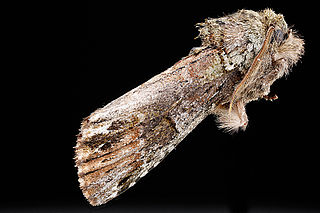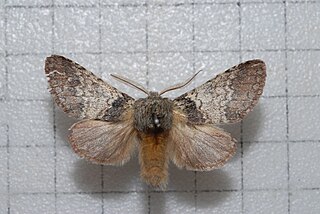
Oenosandridae is a family of Australian noctuoid moths. Genera include:

Notodontidae is a family of moths with approximately 3,800 known species. The family was described by James Francis Stephens in 1829. Moths of this family are found in all parts of the world, but they are most concentrated in tropical areas, especially in the New World.

The coxcomb prominent is a moth of the family Notodontidae. It is a common species throughout the Palearctic realm from Ireland to Japan. It was first described by Carl Linnaeus in his 1758 10th edition of Systema Naturae.

The buff-tip is a moth of the family Notodontidae. It is found throughout Europe and in Asia to eastern Siberia. The species was first described by Carl Linnaeus in his 1758 10th edition of Systema Naturae.

Notodontinae is the nominate subfamily of the moth family Notodontidae. The Ptilodoninae are sometimes merged herein. The genus list is preliminary, as not all Notodontidae have been assigned to subfamilies yet.

Stauropus alternus, the lobster caterpillar, lobster moth or crab caterpillar, is a moth of the family Notodontidae. It is found in the north-eastern Himalaya, Sri Lanka, Sundaland, the Philippines, Sulawesi and the southern Moluccas. It was described by Francis Walker in 1855.

Phalera flavescens is a nocturnal moth of the family Notodontidae. It is found in Taiwan, China, Japan and Korea.

Ephialtias bryce is a moth of the family Notodontidae. It is endemic to the basin of the Rio Tapajos in Brazil.

Heterocampa is a genus of prominent moths in the family Notodontidae. There are about 18 described species in Heterocampa, found in North, Central, and South America.

Disphragis is a genus of moths of the family Notodontidae erected by Jacob Hübner in 1820. The genus is confined to the New World and it contains about 137 species.

Coelodasys unicornis, the unicorn caterpillar moth, unicorn prominent or variegated prominent, is a species of moth in the family Notodontidae. It was first described by James Edward Smith in 1797 and is found in North America south of the Arctic.

Pseudofentonia is a genus of moths of the family Notodontidae erected by Embrik Strand in 1912.

Somera is a genus of moths of the family Notodontidae. The genus was erected by Francis Walker in 1855.
Nystaleinae is a subfamily of the moth family Notodontidae. The subfamily was described by William Trowbridge Merrifield Forbes in 1948.

Syntypistis palladina is a species of moth in the family Notodontidae first described by William Schaus in 1928. It is found in Southern Thailand, Sundaland, the Philippines. The species prefers lowlands and may be seen the whole year up to 2,000 m.
Norraca longipennis is a moth of the family Notodontidae described by Frederic Moore in 1881. It is sometimes classified as Oaura longipennis. It is found in India, Sri Lanka, Andaman Islands, Indochina, Sundaland, Java, Bali, and Philippines.














